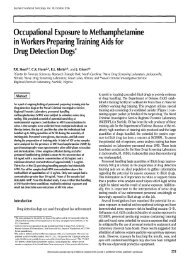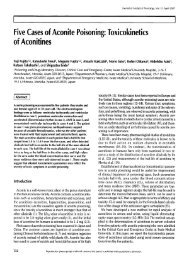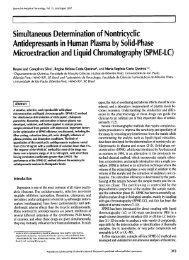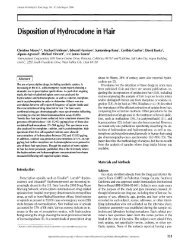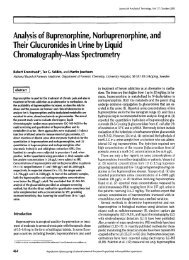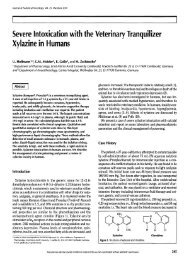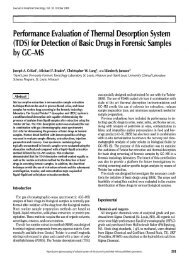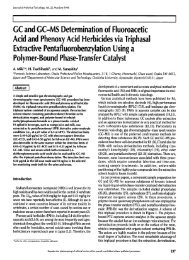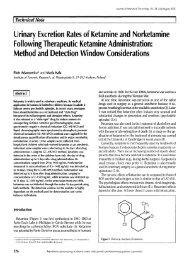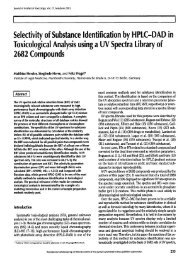A Fatality Due To Alprazolam Intoxication - Journal of Analytical ...
A Fatality Due To Alprazolam Intoxication - Journal of Analytical ...
A Fatality Due To Alprazolam Intoxication - Journal of Analytical ...
Create successful ePaper yourself
Turn your PDF publications into a flip-book with our unique Google optimized e-Paper software.
<strong>Journal</strong> <strong>of</strong> <strong>Analytical</strong> <strong>To</strong>xicology, Vol. 21, May/]urge 1997<br />
well-developed female. Internal examination was unremark-<br />
able except for 60 mL <strong>of</strong> a white granular substance and 40 mL<br />
<strong>of</strong> a green fluid in the stomach. Microscopic findings demon-<br />
strated mild emphysematous changes in the lungs with intra-<br />
alveolar hemorrhages and focal mild pulmonary edema. Spec-<br />
imens collected for toxicological analysis were stored in sterile<br />
polypropylene containers without preservative and were frozen<br />
at -20~ until assayed.<br />
Methods<br />
Materials<br />
<strong>Alprazolam</strong> and (z-hydroxyalprazolam were purchased from<br />
Sigma Chemical (St. Louis, MO). Chlordiazepoxide was ob-<br />
tained from Alltech Applied Science Labs (State College, PA).<br />
<strong>Analytical</strong>-grade sodium borate was purchased from Mallinck-<br />
rodt (St. Louis, MO), and a saturated solution was prepared for<br />
use as a buffer. Reagent-grade methylene chloride, methanol,<br />
and diethylamine were obtained from Fisher Scientific (Fair<br />
Lawn, N J). Solid-phase extraction columns (Chem Elut TM)<br />
were purchased from Varian (Harbor City, CA).<br />
Procedure<br />
<strong>Alprazolam</strong> and e(-hydroxyalprazolam analytical standards<br />
were prepared in methanol at a concentration <strong>of</strong> 100 mg/L.<br />
Chlordiazepoxide (100 rag/L), the internal standard, was also<br />
prepared in methanol. Internal standard (50 IJL) was added to<br />
2 mL <strong>of</strong> blank blood or case specimen and 2 mL <strong>of</strong> buffer<br />
solution. Standard curves for alprazolam and (z-hydroxyalpra-<br />
zolam were prepared at the following concentrations: 0, 0.5,<br />
1.0, 2.5, and 5 mg/L. Homogenates <strong>of</strong> tissue samples were pre-<br />
pared by adding 1 g tissue to 4 mL distilled water. Samples were<br />
vortex mixed and applied to solid-phase extraction columns.<br />
The tubes were rinsed with 1 mL buffer, which was then applied<br />
to the columns. Drugs were eluted from the column with<br />
2 x 7 mL methylene chloride. The eluent was evaporated to<br />
dryness, and the residue was reconstituted with 400 1JL<br />
methanol. An aliquot was injected onto the high-performance<br />
liquid chromatograph (HPLC) for quantitative analysis. The<br />
assay was linear from 0.2 to 5.0 mg/L with a limit <strong>of</strong> sensitivity<br />
<strong>of</strong> 0.2 mg/L. Drug identification was achieved by full-scan gas<br />
Table I. Tissue Distribution <strong>of</strong> <strong>Alprazolam</strong> and<br />
c~-Hydroxyalprazolam in Overdose Death<br />
Specimen <strong>Alprazolam</strong> (x-Hydroxyalprazolam<br />
Heart blood (mg/L) 2.1 Not detected<br />
Subclavian blood (mg/L) 2.3 0.12<br />
Urine (mg/L) 1.0 1.4<br />
Bile (mg/L) 2.8 1.3<br />
Vitreous humor (rag/L) 0.58 Not detected<br />
Liver (mg/kg) 9,2 0.83<br />
Kidney (mg/kg) 3.8 Not detected<br />
Stomach contents 13 mg in 110 mL Not detected<br />
chromatographic-mass spectrometric (GC-MS) analysis and<br />
comparison with an authentic standard.<br />
HPLC instrument conditions<br />
A Waters (Milford, MA) 501 HPLC pump interfaced with a<br />
Waters 715 Ultra Wisp sample processor, a Waters 490E pro-<br />
grammable multiwavelength detector, and a Hewlett-Packard<br />
(Palo Alto, CA) integrator model 3394A were used for the quan-<br />
titative determination <strong>of</strong> alprazolam and c(-hydroxyalprazolam.<br />
A Beckman (San Ramon, CA) ODS column (15 cmx 4.6-ram<br />
i.d., 5-]Jm particle size) was heated to 30~ The detector wave-<br />
length was 240 nm. The mobile phase consisted <strong>of</strong> methanol<br />
and water (60:40) with 1% diethylamine (pH 6) and a flow<br />
rate <strong>of</strong> 1.5 mL/min.<br />
Results and Discussion<br />
A comprehensive toxicological screen was performed on the<br />
heart blood and urine specimens obtained in this case. This<br />
included ethanol and volatile analysis by headspace GC,<br />
radioimmunoassay for morphine, a liquid-liquid extraction<br />
followed by GC-nitrogen-phosphorus detection (NPD) for basic<br />
drugs, and solid-phase extraction with GC-NPD for acidic or<br />
neutral drugs. In addition, color tests were performed for acetaminophen,<br />
aspirin, and ethchlorvynol. The urine was positive<br />
for alprazolam, chlorpheniramine, dextromethorphan, and<br />
doxylarnine. The heart blood was positive for alprazolam only.<br />
Using the normal base extraction procedure therapeutic concentrations<br />
<strong>of</strong> alprazolam are usually undetected because the<br />
limit <strong>of</strong> detection is 0.1 mg/L. However, in this case, alprazolam<br />
was easily detected by GC-NPD after base extraction was performed<br />
and a full-scan electron impact mass spectrum was<br />
obtained.<br />
Quantitation <strong>of</strong> alprazolam and c(-hydroxyalprazolam in biological<br />
specimens was performed by reversed-phase HPLC.<br />
This procedure is commonly used for the analysis <strong>of</strong> benzodiazepines<br />
(7-9). In this assay, the order <strong>of</strong> elution was<br />
~-hydroxyalprazolam, alprazolam, and the internal standard.<br />
The relative retention times with respect to internal standard<br />
were 0.70 and 0.84 rain for (x-hydroxyalprazolam and alprazolam,<br />
respectively. Chlordiazepoxide was chosen as the<br />
internal standard to enable baseline resolution <strong>of</strong> the three<br />
drugs while optimizing analysis time.<br />
The quantitative results obtained in this case are shown in<br />
Table I. <strong>Alprazolam</strong> was detected in all specimens analyzed.<br />
Concentrations <strong>of</strong> alprazolam >2 mg/L were measured in both<br />
heart and subclavian blood specimens. There was good agreement<br />
in the alprazolam concentration between the two blood<br />
specimens. The alprazolam concentration in liver was approximately<br />
2.4 times the concentration in kidney. The concentration<br />
<strong>of</strong> parent drug measured in bile was approximately three<br />
times the concentration determined in urine, which suggested<br />
that this specimen would be useful for an initial screening for<br />
those assays that are not targeted to drug metabolites. This case<br />
also showed a readily detectable concentration <strong>of</strong> alprazolam in<br />
the vitreous humor. Given the relative protection <strong>of</strong> the vit-<br />
219



